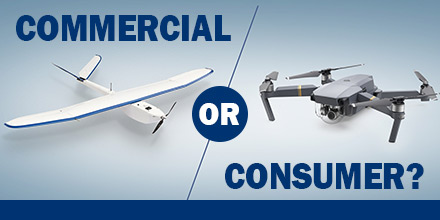 Is there a difference in the accuracy of survey data from a consumer “retail” system versus a commercial system? If so, what is that difference?
Over the Summer, the team at Altavian -- manufacturer of the Nova F7200 -- decided to find out.
Is there a difference in the accuracy of survey data from a consumer “retail” system versus a commercial system? If so, what is that difference?
Over the Summer, the team at Altavian -- manufacturer of the Nova F7200 -- decided to find out.
Commercial or Consumer?
For a variety of application, including aerial data collection, commercial UAV systems are believed to far exceed the capabilities of a retail drone. However, few surveyors have the luxury of comparing a commercial versus a consumer platform in a real-world environment.
So, the Altavian Team decided to run a data collection survey test between a DJI Mavic Pro and an Altavian Nova F7200.
The end result? The Nova F7200 produced data ten times more accurate than the Mavic in both horizontal and vertical deviation.
The control: traditional ground survey
Establishing a reliable control for data comparison was a critical aspect of the experiment. The team decided on a traditional ground survey to serve as the data control baseline. Below is an overview of the ground survey.
Equipment used
- Trimble R7 GNSS RTK Rover
- Trimble Zephyr Geodetic Antenna
- Leica TCR405 Power
- Leica Sprinter
Survey Description
This survey established ground control for comparing the survey accuracy of drone data collected by a DJI Mavic Pro and Altavian’s Nova F7200 equipped with an MP-22 payload.
Collection of Control
The rover was placed on both the South Points for four hours each. The resulting coordinate error are LAT error at .005 m., LONG error .009 m., and ELEV error .033 m. (point 1). For (point 2) LAT error at .006 m., LONG error at .021 m., and ELEV error at .042 m.
Survey Procedure
The survey points were 8’’ spikes driven through checked linoleum tiles. The points were shot using a Leica TCR405 total station. The elevations were collected using a Leica Sprinter.
Survey Results
The vertical survey ended with a misclosure of .0095 m.
Each aircraft collected two sets of data which the team compared to With previously established Ground Control Points (GCP) from the ground survey, there was a clear way to determine how the accuracy of consumer and commercial systems stacked up.
Retail System: DJI Mavic Pro
The team's primary concern was to ensure that the smaller, consumer system had the same GSD as the Nova. To ensure this, the Mavic flew just shy of 60 m. to maintain a calculated GSD of 1.97 cm.
The Mavic Flight used 317 photos with a median of 51976 key points per image, and a median of 30452.2 matches per calibrated image. The total flight time for the Mavic was 25 minutes.
The data was processed in Pix4Dmapper Pro and then compared to the results from the ground survey. The result was the Mavic had a deviation from the GCPs at 1.9 m. horizontally and 1.22 m. vertically. Finally, the mean RMS error for the Mavic was 0.996 m.
Commercial System: Nova F7200
Thet team equipped the Nova with their modular MP-22 payload carrying a DSLR Canon SL1 camera.
It flew at its standard 90 m. altitude maintaining a GSD of 1.97 cm. The Nova Flight used 238 images with a median of 40199 key points per image, and a median of 25492.3 matches per calibrated image. Total flight time for the Nova was 9 minutes. The data process using Pix4Dmapper Pro was identical to create a comparable data sets between the Mavic and Nova.
Once again, the team compared the data to the ground survey. They found that the Nova had a 0.19 m. horizontal and 0.17 m. vertical deviation from the GCPs. The mean RMS error for the Nova was 0.015 m.
Results: Comparing the Survey Accuracy of Drone Data
When the team examined the two data sets against the accuracy of the ground survey, it revealed a clear winner. The Altavian commercial system thoroughly out paced the consumer system.
Now, the benefits of investing in a commercial system were measurable. Also measurable were the risks involved in selecting a consumer drone for such a task.
Though consumer drones are a great fit for a number of applications, there are risks involved when choosing such a vehicle for other endeavors. An off-the-shelf consumer drone offers an attractive price tag. However, that price tag also comes with limitations when it comes to the accuracy and fidelity of data that, ultimately, makes it more toy than tool.
The advantages of a commercial system like the Nova F7200 for accurate survey data are clear. In the long run, such systems are a safer long-term investment.
Commercial drones designed for survey accuracy cut workload down from weeks to days. Such systems enable users to complete projects faster and with more cost efficiency. And, such systems beat the pants off walking that survey line day in day out rain or shine.
Find out more about
Altavian's commercial line of solutions at Unmanned Systems Source.
 Is there a difference in the accuracy of survey data from a consumer “retail” system versus a commercial system? If so, what is that difference?
Over the Summer, the team at Altavian -- manufacturer of the Nova F7200 -- decided to find out.
Is there a difference in the accuracy of survey data from a consumer “retail” system versus a commercial system? If so, what is that difference?
Over the Summer, the team at Altavian -- manufacturer of the Nova F7200 -- decided to find out.

